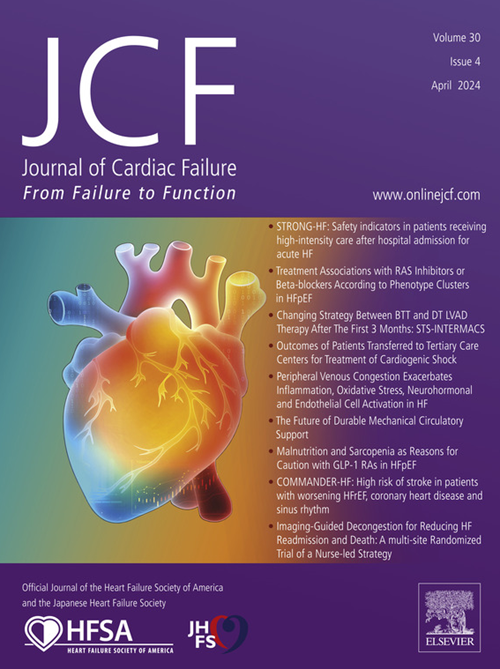HFSA 科学声明:基于设备的心力衰竭治疗方法更新。
IF 6.7
2区 医学
Q1 CARDIAC & CARDIOVASCULAR SYSTEMS
引用次数: 0
摘要
鉴于心力衰竭(HF)发病率和相关死亡率的上升,心力衰竭已成为当代的一大挑战。针对射血分数降低型心力衰竭(HFrEF)的基础药物疗法已经确立,包括血管紧张素受体肾素抑制剂(ARNIs)、β-受体阻滞剂、矿物质皮质激素受体拮抗剂(MRAs)和钠-葡萄糖协同转运体抑制剂(SGLTis)。此外,最近的试验还确定了 SGLTis 在射血分数保留型心房颤动(HFpEF)患者中的作用。然而,即使使用了这些疗法,HFrEF 和 HFpEF 患者仍然存在很大的残余风险。在药物治疗取得进展的同时,基于设备的疗法也显示出了治疗高血压的疗效,包括植入式心律转复除颤器(ICD)和心脏再同步化疗法(CRT)。最近,心脏收缩力调节 (CCM) 和巴反射激活疗法 (BAT) 等设备也获得了美国食品及药物管理局(FDA)的批准,但这些设备缺乏全面的指南建议。本科学报告概述了慢性高血压尚未满足的需求,回顾了当代数据,并提供了将基于新型设备的疗法纳入当前临床工作流程的框架。它强调了早期诊断和表型分析、适当的患者分层以及结合药物和器械疗法的个性化方法的重要性。该文件还强调了进一步研究器械相互作用和患者选择的必要性,以优化治疗效果,同时认识到需要采取更加综合的治疗方法,以解决高血压管理中尚未满足的需求和残余风险。本文章由计算机程序翻译,如有差异,请以英文原文为准。
HFSA Scientific Statement: Update on Device Based Therapies in Heart Failure
Heart failure (HF) is 1 of the major challenges of our time, given its increase in prevalence and related mortality rates. Foundational pharmacological therapies, including angiotensin receptor neprilysin inhibitors (ARNIs), beta-blockers, mineralocorticoid receptor antagonists (MRAs), and sodium-glucose co-transporter inhibitors (SGLTis), have been established for HF with reduced ejection fraction (HFrEF). Moreover, recent trials have established the role of SGLTis in patients with HF with preserved ejection fraction (HFpEF). However, even with these therapies, a substantial residual risk persists in both HFrEF and HFpEF. Alongside pharmacological advancements, device-based therapies have shown efficacy in HF management, including implantable cardioverter-defibrillators (ICDs) and cardiac resynchronization therapy (CRT). More recently, devices such as cardiac contractility modulation (CCM) and baroreflex activation therapy (BAT) have been approved by the FDA, although they lack comprehensive guideline recommendations. This scientific statement outlines the unmet needs in chronic HF, reviews contemporary data and provides a framework for integrating novel device-based therapies into current clinical workflows. It emphasizes the importance of early diagnosis and phenotyping, proper patient stratification and a personalized approach to combining pharmacological and device therapies. The document also highlights the need for further research into device interactions and patient selection to optimize outcomes, while recognizing the need for a more integrated approach to treatment so as to address the unmet needs and residual risks in HF management.
求助全文
通过发布文献求助,成功后即可免费获取论文全文。
去求助
来源期刊

Journal of Cardiac Failure
医学-心血管系统
CiteScore
7.80
自引率
8.30%
发文量
653
审稿时长
21 days
期刊介绍:
Journal of Cardiac Failure publishes original, peer-reviewed communications of scientific excellence and review articles on clinical research, basic human studies, animal studies, and bench research with potential clinical applications to heart failure - pathogenesis, etiology, epidemiology, pathophysiological mechanisms, assessment, prevention, and treatment.
 求助内容:
求助内容: 应助结果提醒方式:
应助结果提醒方式:


